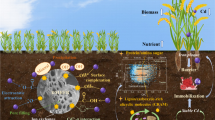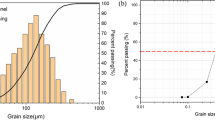Abstract
Background and aim
Iron plaque (IP) on rice (Oryza sativa) root surface consists of reddish brown IP (RIP) and non-reddish brown IP (NRIP), however, their extraction and characterization need further studies.
Methods
A reliable method combining chemical and X-ray diffraction (XRD) analysis was introduced to discriminate RIP and NRIP on root surface of rice plants subjected to different phosphate (P) treatments.
Results
RIP appeared only on P-deficient rice root surface, and NRIP occurred on both P-deficient and P-sufficient rice root surface. Both RIP and NRIP could be extracted by dithionite-citrate-bicarbonate while only NRIP could be extracted by 0.1 M tetrasodium pyrophosphate (Na4P2O7) specifically. NRIP on P-sufficient root surface was 2.42 times of that on P-deficient plants. Iron speciation analysis showed that the total, amorphous and crystalline iron on P-deficient root surface were 1.47-, 1.50- and 1.35-times of those of P-sufficient plants, respectively. XRD analysis further confirmed that IP on both P-sufficient and P-deficient root surface presented as amorphous features. Dominant minerals of NRIP were iron phosphates, while those of RIP were ferric (hydr)oxides. The specific removal effect of 0.1 M Na4P2O7 for NRIP was also verified by XRD.
Conclusion
In this study, phosphate levels in nutrient solution significantly influence the formation of RIP and NRIP on rice root surface. Main components of RIP and NRIP are ferric (hydr)oxides and iron phosphates, respectively. They can be separated by 0.1 M Na4P2O7.






Similar content being viewed by others
References
Bacha RE, Hossner LR (1977) Characteristics of coatings formed on rice roots as affected by iron and manganese additions. Soil Sci Soc Am J 41:931–935
Chabbi A (1999) Juncus bulbosus as a pioneer species in acidic lignite mining lakes: interactions, mechanism and survival strategies. New Phytol 144:133–142
Chen CC, Dixon JB, Turner FT (1980) Iron coatings on rice roots: morphology and models of development. Soil Sci Soc Am J 44:1113–1119
Chong YX, Yu GW, Cao XY, Zhong HT (2013) Effect of migration of amorphous iron oxide on phosphorous spatial distribution in constructed wetland with horizontal sub-surface flow. Ecol Eng 53:126–129
Claff SR, Sullivan LA, Burton ED, Bush RT (2010) Asequential extraction procedure for acid sulfate soils: paritioning of iron. Geoderma 155:224–230
de Araujo TO, de Freitas-Silva L, Nova Santana BV, Kuki KN, Pereira EG, Azevedo AA, da Silva LC (2015) Morphoanatomical responses induced by excess iron in roots of two tolerant grass species. Environ Sci Pollut R 22:2187–2195
Franco A, Rufo L, Rodriguez N, Amils R, de la Fuente V (2013) Iron absorption, localization, and biomineralization of Cynodon dactylon, a perennial grass from the Rio Tinto basin (SW Iberian Peninsula). J Plant Nutr Soil Sci 176:836–842
Fu YQ, Liang JP, Yu ZW, Wu DM, Cai KZ, Shen H (2011) Effect of different iron forms on iron plaque on root surface and iron uptake in rice seedlings. Plant Nutri Fert Sci 17(5):1050–1057
Fu YQ, Yang XJ, Wu DM, Shen H (2014a) Effect of phosphorus on reddish brown iron plaque on root surface of rice seedlings and their nutritional effects. Sci Agric Sin 47:1072–1085
Fu YQ, Yang XJ, Shen H (2014b) The physiological mechanism of enhanced oxidizing capacity of rice (Oryza sativa L.) roots induced by phosphorus deficiency. Acta Physiol Plant 36:179–190
Hansel CM, Fendorf S, Sutton S, Newville M (2001) Characterization of Fe plaque and associated metals on the roots of mine-waste impacted aquatic plants. Environ Sci Technol 35:3863–3868
Hossain MB, Jahiruddin M, Loeppert RH, Panaullah GM, Islam MR, Duxbury JM (2009) The effects of iron plaque and phosphorus on yield and arsenic accumulation in rice. Plant Soil 317:167–176
Hu Y, Li JH, Zhu YG, Huang YZ, Hu HQ, Christie P (2005) Sequestration of as by iron plaque on the roots of three rice (Oryza sativa L.) cultivars in a low-P soil with or without P fertilizer. Environ Geochem Health 27:169–176
Iuliano M, Ciavatta L, de Tommaso G (2007) On the solubility constant of strengite. Soil Sci Soc Am J 71:1137–1140
Kaiser K, Zech W (1996) Defects in estimation of aluminum in humus complexes of podzolic soils by pyrophosphate extraction. Soil Sci 161:452–458
Kitagawa Y (2005) Characteristics of clay minerals in podzols and podzolic soils. Soil Sci Plant Nutr 51:151–158
Lee C, Hsieh Y, Lin T, Lee D (2013) Iron plaque formation and its effect on arsenic uptake by different genotypes of paddy rice. Plant Soil 363:231–241
Li F (2006) Physical chemistry of soil. Chemical Industry Press, Beijing
Liang Y, Zhu YG, Xia Y, Li Z, Ma Y (2006) Iron plaque enhances phosphorus uptake by rice (Oryza sativa) growing under varying phosphorus and iron concentrations. Ann Appl Biol 149:305–312
Liu HJ, Zhang JL, Christie P, Zhang FS (2008) Influence of iron plaque on uptake and accumulation of Cd by rice (Oryza sativa L.) seedlings grown in soil. Sci Total Environ 394(2–3):361–368
McDowell RW, Sharpley AN (2003) Phosphorus solubility and release kinetics as a function of soil test P concentration. Geoderma 112:143–154
Mei XQ, Ye ZH, Wong MH (2009) The relationship of root porosity and radial oxygen loss on arsenic tolerance and uptake in rice grains and straw. Environ Pollut 157:2550–2557
Mei XQ, Wong MH, Yang Y, Dong HY, Qiu RL, Ye ZH (2012) The effects of radial oxygen loss on arsenic tolerance and uptake in rice and on its rhizosphere. Environ Pollut 165:109–117
Mengel K, Kirkby EA, Kosegarten H, Appel T (2001) Principles of plant nutrition. Kluwer Academic Publishers, Dordercht
Mi W, Cai J, Tuo Y, Zhu H, Hua Y, Zhao J, Zhou W, Zhu D (2013) Distinguishable root plaque on root surface of Potamogeton crispus grown in two sediments with different nutrient status. Limnology 14(1):1–11
Montas-Ramirez L, Claassen N, Moawad AM (2003) Determination of Fe2+ in rice leaves (Oryza sativa L.) by using the chelator BPDS alone or combined with the chelator EDTA. J Plant Nutr 26(10–11):2023–2030
Patrick Jr WH, Khalid RA (1974) Phosphate release and sorption by soils and sediments: effect of aerobic and anaerobic conditions. Science 186:53–55
Petersen GW, Corey RB (1966) A modified Chang and Jackson procedure for routin fractionation of inorganic soil phosphates. Soil Sci Soc Amer 30:563–565
Poulton SW, Canfield DE (2005) Development of a sequential extraction procedure for iron: implications for iron partitioning in continentally derived particulates. Chem Geol 214:209–221
Senn A, Kaegi R, Hug SJ, Hering JG, Mangold S, Voegelin A (2015) Composition and structure of Fe(III)-precipitates formed by Fe(II) oxidation in water at near-neutral pH: interdependent effects of phosphate, silicate and Ca. Geochim Cosmochim Acta 162:220–246
Seyfferth AL (2015) Abiotic effects of dissolved oxyanions on iron plaque quantity and mineral composition in a simulated rhizosphere. Plant Soil. doi:10.1007/s11104-015-2597-z
Syu C, Lee C, Jiang P, Chen M, Lee D (2014) Comparison of as sequestration in iron plaque and uptake by different genotypes of rice plants grown in as-contaminated paddy soils. Plant Soil 374:411–422
Tandy S, Bossart K, Mueller R, Ritschel J, Hauser L, Schulin R, Nowack B (2004) Extraction of heavy metals from soils using biodegradable chelating agents. Environ Sci Technol 38:937–944
Taylor GJ, Crowder AA (1983) Use of the DCB technique for extraction of hydrous iron oxides from roots of wetland plants. Am J Bot 70:1254–1257
Tessier A, Campbell PGC, Bisson M (1979) Sequential extraction procedure for the speciation of particulate trace metals. Anal Chem 51(7):844–851
Turonova A, Galova M, Gernatova M (2008) Study of electroless copper deposition on Fe powder. Part Sci Technol 26(2):126–135
Voegelin A, Senn A, Kaegi R, Hug SJ, Mangold S (2013) Dynamic Fe-precipitate formation induced by Fe(II) oxidation in aerated phosphate-containing water. Geochim Cosmochim Acta 117:216–231
Wang T, John P (1999) Iron oxidation states on root surfaces of a wetland plant (Phragmites australis). Soil Sci Soc Am J 63:247–252
Woolson EA, Axley JH, Kearney PC (1971) The chemistry and phytotoxicity of arsenic in soils: I. contaminated field soils. Soil Sci Soc Amer 35:938–943
Xu B, Yu S (2013) Root iron plaque formation and characteristics under N2 flushing and its effects on translocation of Zn and Cd in paddy rice seedlings (Oryza sativa). Ann Bot 111:1189–1195
Yamaguchi N, Ohkura T, Takahashi Y, Maejima Y, Arao T (2014) Arsenic distribution and speciation near rice roots influenced by iron plaques and redox conditions of the soil matrix. Environ Sci Technol 48:1549–1556
Yokosho K, Yamaji N, Ueno D, Mitani N, Ma JF (2009) OsFRDL1is a citrate transporter required for efficient translocation of iron in rice. Plant Physiol 149(1):297–305
Yoshida S, Douglas A, Forno JC (1976) Laboratory manual for physiological studies of rice. IRRI, Los Banos, Philippines
Zhang X, Zhang F, Mao D (1998) Effect of iron plaque outside roots on nutrient uptake by rice (Oryza sativa L.). zinc uptake by Fe-deficient rice. Plant Soil 202:33–39
Zhang YS, Lin XY, Werner W (2003) The effect of soil flooding on the transformation of Fe oxides and the adsorption/desorption behavior of phosphate. J Plant Nutr Soil Sci 166:68–75
Zhou H, Zeng M, Zhou X, Liao BH, Peng PQ, Hu M, Zhu W, Wu YJ, Zou ZJ (2015) Heavy metal translocation and accumulation in iron plaques and plant tissues for 32 hybrid rice (Oryza sativa L.) cultivars. Plant Soil 386(1–2):317–329
Acknowledgments
We acknowledged Ms. Yun Yan and Mr. Gang-Ling He in College of Materials and Energy, South China Agricultural University (SCAU) for their direction in sample XRD analysis, and also expressed our thanks to Mr. Kang Chen in Root Biology Center, SCAU for his assistance in sample vacuum freezing. This study was supported by National Natural Science Foundation of China (No. 31372125) and Guangzhou Science and Technology Plan Program (2014 J4100240).
Author information
Authors and Affiliations
Corresponding author
Additional information
Responsible Editor: Michael A. Grusak.
Y-Q Fu and X-J Yang made equal contribution to this article
Electronic supplementary material
11104_2016_2802_MOESM1_ESM.pdf
Phase report The full data of mineral phase report of 4 samples (CK + Fe; −P + Fe; CK + Fe after Na4P2O7 treatment; −P + Fe after Na4P2O7 treatment). The figure of merit (FOM) was calculated based on the similarity of pattern and characteristic peaks of powder diffraction file. The lower FOM, the higher possibility for mineral phase that the report suggests. (PDF 2.57 mb)
Rights and permissions
About this article
Cite this article
Fu, YQ., Yang, XJ., Ye, ZH. et al. Identification, separation and component analysis of reddish brown and non-reddish brown iron plaque on rice (Oryza sativa) root surface. Plant Soil 402, 277–290 (2016). https://doi.org/10.1007/s11104-016-2802-8
Received:
Accepted:
Published:
Issue Date:
DOI: https://doi.org/10.1007/s11104-016-2802-8




